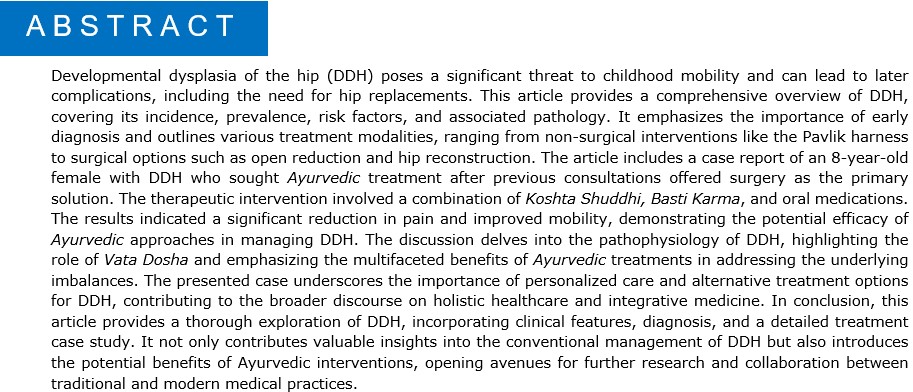Ayurvedic Management of Developmental Displasia of the Hip: A Case Report
DOI:
https://doi.org/10.21760/jaims.9.1.41Keywords:
Developmental displasia of the hip, Kosta Shuddhi, Basti Karma, Vata Dosha, AyurvedaAbstract
Developmental dysplasia of the hip (DDH) poses a significant threat to childhood mobility and can lead to later complications, including the need for hip replacements. This article provides a comprehensive overview of DDH, covering its incidence, prevalence, risk factors, and associated pathology. It emphasizes the importance of early diagnosis and outlines various treatment modalities, ranging from non-surgical interventions like the Pavlik harness to surgical options such as open reduction and hip reconstruction. The article includes a case report of an 8-year-old female with DDH who sought Ayurvedic treatment after previous consultations offered surgery as the primary solution. The therapeutic intervention involved a combination of Koshta Shuddhi, Basti Karma, and oral medications. The results indicated a significant reduction in pain and improved mobility, demonstrating the potential efficacy of Ayurvedic approaches in managing DDH. The discussion delves into the pathophysiology of DDH, highlighting the role of Vata Dosha and emphasizing the multifaceted benefits of Ayurvedic treatments in addressing the underlying imbalances. The presented case underscores the importance of personalized care and alternative treatment options for DDH, contributing to the broader discourse on holistic healthcare and integrative medicine. In conclusion, this article provides a thorough exploration of DDH, incorporating clinical features, diagnosis, and a detailed treatment case study. It not only contributes valuable insights into the conventional management of DDH but also introduces the potential benefits of Ayurvedic interventions, opening avenues for further research and collaboration between traditional and modern medical practices.
Downloads
References
Schwend RM, Shaw BA, Segal LS. Evaluation and treatment of developmental hip dysplasia in the newborn and infant. Pediatr Clin North Am. 2014;61:1095–1107.
Patel H. Preventive health care, 2001 update: screening and management of developmental dysplasia of the hip in newborns. Can Med Assoc J. 2001.
Guille JT, Pizzutillo PD, MacEwen GD. Development dysplasia of the hip from birth to six months. J Am Acad Orthop Surg. 2000;8:232-242. PMID: 10951112
Klisic PJ. Congenital dislocation of the hip--a misleading term: brief report. J Bone Joint Surg Br. 1989;71:136. PMID: 2914985
Aronsson DD, Goldberg MJ, Kling TF, Roy DR. Developmental dysplasia of the hip. Pediatrics. 1994;94:201-208. PMID: 8036074
Lehmann HP, et al. Developmental dysplasia of the hip practice guideline: technical report. Pediatrics. 2000.
Dezateux C, et al. Performance, treatment pathways, and effects of alternative policy options for screening for developmental dysplasia of the hip in the United Kingdom. Arch Dis Child. 2003.
American Academy of Pediatrics. Clinical practice guideline: early detection of developmental dysplasia of the hip. Pediatrics. 2000;105:896–905.
Bialik V, et al. Developmental dysplasia of the hip: a new approach to incidence. Pediatrics. 1999;103:93–99.
Andersson JE. Neonatal hip instability: normal values for physiological movement of the femoral head determined by an anterior-dynamic ultrasound method. J Pediatr Orthop. 1995.
Bache CE, Clegg J, Herron M. Risk factors for developmental dysplasia of the hip: ultrasonographic findings in the neonatal period. J Pediatr Orthop B. 2002;11:212–218.
Imrie M, et al. Is ultrasound screening for DDH in babies born breech sufficient? J Child Orthop. 2010;4:3–8.
Stevenson DA, et al. Familial predisposition to developmental dysplasia of the hip. J Pediatr Orthop. 2009;29:463–466.
Woolacott N, et al. Systematic review of the clinical and cost effectiveness of ultrasound in screening for developmental dysplasia of the hip in newborns. University of York, York, UK. 2005.
Thomas SR. A review of long-term outcomes for late presenting developmental hip dysplasia. Bone Joint J. 2015;97-B:729–733.
Vitale MG, Skaggs DL. Developmental dysplasia of the hip from six months to four years of age. J Am Acad Orthop Surg. 2001;9:401–411.
Gillingham BL, Sanchez AA, Wenger DR. Pelvic osteotomies for the treatment of hip dysplasia in children and young adults. J Am Acad Orthop Surg. 1999;7:325–337.
Holman J, et al. Long-term follow-up of open reduction surgery for developmental dislocation of the hip. J Pediatr Orthop. 2012;32:121–124.
Mubarak SJ, Bialik V. Pavlik: the man and his method. J Pediatr Orthop. 2003;23:342–346.
Wilkinson AG, Sherlock DA, Murray GD. The efficacy of the Pavlik harness, the Craig splint and the von Rosen splint in the management of neonatal dysplasia of the hip. J Bone Joint Surg Br. 2002;84:716–719.
Cashman JP, et al. The natural history of developmental dysplasia of the hip after early supervised treatment in the Pavlik harness. J Bone Joint Surg Br. 2002;84:418–425.
Fabry G. Clinical practice: the hip from birth to adolescence. Eur J Pediatr. 2010;169:143–148.
Kokavec M, et al. Pavlik’s method: a retrospective study. Arch Orthop Trauma Surg. 2006;126:73–76.
Peled E, et al. Treatment of Graf’s ultrasound class III and IV hips using Pavlik’s method. Clin Orthop Relat Res. 2008;466:825–829.
Grill F, et al. The Pavlik harness in the treatment of congenital dislocating hip: report on a multicenter study of the European Paediatric Orthopaedic Society. J Pediatr Orthop. 1988;8:1–8.
Malvitz TA, Weinstein SL. Closed reduction for congenital dysplasia of the hip. Functional and radiographic results after an average of thirty years. J Bone Joint Surg Am. 1994;76:1777–1792.
Tarassoli P, et al. The medial approach for the treatment of children with developmental dysplasia of the hip. Bone Joint J. 2014;96-B:406–413.
Gillingham BL, Sanchez AA, Wenger DR. Pelvic osteotomies for the treatment of hip dysplasia in children and young adults. J Am Acad Orthop Surg. 1999;7:325–337.
Perlik PC, Westin GW, Marafioti RL. A combination pelvic osteotomy for acetabular dysplasia in children. J Bone Joint Surg Am. 1985;67:842–850.
Bursali A, Tonbul M. How are outcomes affected by combining the Pemberton and Salter osteotomies? Clin Orthop Relat Res. 2008;466:837–846.
Kotz R, et al. Long-term experience with Chiari’s osteotomy. Clin Orthop Relat Res. 2009;467:2215–2220.
Deepti KA, et al. Role of Matra Basti (Enema) over Abhyanga (Massage) and Sweda (Sudation) in Reducing Spasticity in Cerebral Palsy with Suddha Bala Taila - A Randomized Comparative Clinical Study. Int J Ayur. Pharma Research. 2014;2(2):47-52.
Choudhary KR. Recent advances in Ayurvedic management of cerebral palsy affected children. Int J Res Ayurveda Pharm. 2014;5(6):642-647.















